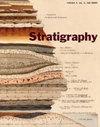Cretaceous (Aptian-Maastrichtian) stratigraphy of the Shiranish Islam area, northern Iraq
IF 0.9
3区 地球科学
Q3 GEOLOGY
引用次数: 1
Abstract
ABSTRACT: The Kurdistan region of northern Iraq contains world-class outcrops that make it possible to examine the Cretaceous deep and shallow marine Tethyan faunal succession. Six separate sections covering the Shiranish, Bekhme, Mergi and Qamchuqa formations have been investigated in this study from the Shiranish Islam area. A number of papers have been published on this area, but no comprehensive biostratigraphic record has been published that fully documents the Cretaceous stratigraphy and the chronostratigraphic interpretation of the succession. As a result, this has led to significant lithostratigraphic and chronostratigraphic uncertainties. The upper part of the Qamchuqa is pervasively dolomitized. Rare occurrences of foraminifera are found in less dolomitized intervals in thin-section indicating an early - middle Albian age for the top of the formation. A thin interval comprising the Gir Bir Formation is Cenomanian in age and is present between the top of the Qamchuqa Formation and the overlying conglomerate. Historical studies indicate that the Turonian Mergi Formation occurs between the Qamchuqa and Bekhme formations, but our field and analytical data does not support it as a discrete lithostratigraphic entity, as Turonian aged faunas were not recognized. The conglomerate separating the top of the Gir Bir and base of the Bekhme is subdivided into three units (A, B & C). Units A and B are late Cenomanian to early Turonian age, whilst Unit C is of Campanian age. A significant hiatus separates the Gir Bir and the Bekhme, which encompasses the intra Turonian to Santonian. The limestone facies of the lower part of the Bekhme Formation contains rich benthic foraminiferal faunas (miliolids, Pseudedomia, Cuneolina) of early - early middle Campanian age. This lower - lower middle Campanian section at Shiranish Islam is considered to be equivalent of the upper part of the Sa'di Formation in central Iraq and is therefore re-assigned on the basis of chronostratigraphic attribution to the Sa'di (equivalent) herein. The top of the early - early middle Campanian biofacies is abruptly truncated by an omission surface, marked by an erosive base, an influx of clastic material and a major up-section biofacies change characterized by an influx of Pseudosiderolites and Orbitoides representing an intra-Campanian hiatus. The bioevent sequence suggests that this hiatus at Shiranish Islam comprises at least the middle Campanian (upper part of the G. elevata Zone) into the late Campanian (intra R. calcarata Zone), from approximately 80.64 Ma to 76.09 Ma with 4.55 my missing. The middle part of the Bekhme Formation comprising the Pseudosiderolites - Orbitoides facies is thin (c. three meters) and is re-assigned to the Lower Bekhme Member. The boundary between the Lower Bekhme Member and the Upper Bekhme Member is conformable and marked by a gradual up-section reduction in the size and presence of larger benthic foraminifera (Orbitoides, Pseudosiderolites) and an increase in the planktic component (small planktics and calcispheres). This trend of gradually increasing water depth continues into the Shiranish Formation, with no apparent major breaks in deposition. The Campanian - Maastrichtian boundary falls within Unit A of the Shiranish Formation. Deposition of the Shiranish continued into the earliest late Maastrichtian and is unconformably overlain by the Danian Kolosh Formation. The hiatus between the top of the Cretaceous and the Paleocene extends from the early late Maastrichtian (c. 68.86 Ma) to the upper part of the Danian (62.2 Ma) with an estimated duration of 6.66 my.伊拉克北部Shiranish Islam地区白垩纪(Aptian-Maastrichtian)地层学
摘要:伊拉克北部库尔德斯坦地区拥有世界级的露头,这使得研究白垩纪深海和浅海特提斯动物演替成为可能。本研究对Shiranish Islam地区的六个独立剖面进行了调查,包括Shiranish、Bekhme、Mergi和Qamchuqa地层。关于该地区已发表了许多论文,但尚未发表全面的生物地层学记录,以充分记录白垩纪地层学和对演替的年代地层解释。因此,这导致了岩石地层学和年代地层学的重大不确定性。Qamchuqa上部普遍白云化。在薄层白云化程度较低的层段中发现了罕见的有孔虫,表明该地层顶部为早-中期阿勒颇时代。在Qamchuqa组顶部和上覆砾岩之间,有一层由Gir Bir组组成的薄层,其年龄为Cenomanian。历史研究表明,Turonian Mergi组位于Qamchuqa组和Bekhme组之间,但我们的野外和分析资料不支持它作为一个独立的岩石地层实体,因为没有发现Turonian的古动物群。吉尔比尔顶部和贝克梅底部的砾岩被划分为3个单元(A、B、C),其中A、B单元为晚塞诺曼尼亚期至早土鲁尼亚期,C单元为坎帕尼亚期。吉尔比尔河和贝克梅河之间有一个明显的间隔,其中包括图尔尼安河到圣东尼安河。Bekhme组下部灰岩相发育丰富的早-中坎帕尼亚早期底栖有孔虫动物群(千孔虫、伪孔虫、孔孔虫)。Shiranish Islam的中下部坎帕尼亚剖面被认为相当于伊拉克中部Sa'di组的上部,因此根据年代地层归属重新分配给此处的Sa'di组(等效)。早-中坎帕纪生物相顶部突然被遗漏面截断,其特征是侵蚀基底、碎屑物质的流入,以及主要的上剖面生物相变化,其特征是假橄榄石和轨道岩的流入,代表了坎帕纪内部的裂谷。生物事件序列表明,Shiranish Islam的裂孔至少包括中坎帕纪(G. elevata带上部)到晚坎帕纪(R. calcarata带内),时间约为80.64 Ma ~ 76.09 Ma,缺失4.55 Ma。由伪菱形岩-轨道岩相组成的Bekhme组中部较薄(约3米),属于下Bekhme段。下贝克梅段和上贝克梅段之间的边界是整合的,其特征是尺寸逐渐减小,较大的底栖有孔虫(Orbitoides, Pseudosiderolites)的存在和浮游生物成分(小型浮游生物和砂砾石)的增加。这种逐渐增加水深的趋势一直延续到Shiranish组,沉积没有明显的大断裂。坎帕尼亚-马斯特里赫特边界位于Shiranish组A单元内。Shiranish的沉积一直持续到最早的马斯特里赫特晚期,并被Danian Kolosh组不整合覆盖。白垩纪顶部与古新世之间的断裂期从马斯特里希晚期早期(约68.86 Ma)延伸至大年上部(约62.2 Ma),估计持续时间为6.66 Ma。
本文章由计算机程序翻译,如有差异,请以英文原文为准。
求助全文
约1分钟内获得全文
求助全文
来源期刊

Stratigraphy
地学-地质学
CiteScore
1.80
自引率
6.70%
发文量
0
审稿时长
>12 weeks
期刊介绍:
The journal’s mission is to publish peer-reviewed papers that use modern stratigraphic tools – biostratigraphy, chemostratigraphy, magnetostratigraphy, cyclostratigraphy, sequence stratigraphy, climatostratigraphy, lithostratigraphy, GSSPs and more – to explore broad ideas in earth history.
 求助内容:
求助内容: 应助结果提醒方式:
应助结果提醒方式:


